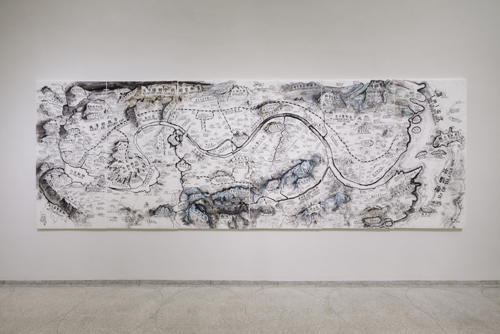
Qiu Zhijie, Map of “Art and China after 1989
Qiu Zhijie, Map of “Art and China after 1989: Theater of the World,” 2017.
Ink on paper, mounted to silk, five panels, 240 x 720 cm overall.
Solomon R.Guggenheim Museum, New York,
Gift of the artist with additional funds contributed by the International Director’s Council T31.2017
© Qiu Zhijie.

Photo: Courtesy the artist; right Qiu Zhijie, Assignment No. 1: Copying the “Orchid Pavilion Preface” 1,000 Times, 1990/95.
Color video, silent, 35 min.Courtesy the artist; Ink on paper, 70 x 160 cm.
Collection of Chang Tsong-zung © Qiu Zhijie
Art and China after 1989: Theater of the World is a large exhibition of contemporary art from China that spans the years 1989 to 2008, which can be seen as the most transformative period of modern Chinese and recent world history. The period extends from the end of the Cold War and the spread of globalization to the rise of China as a global presence, culminating in the 2008 Beijing Olympics. The exhibition highlights approximately 70 key Chinese artists and artist collectives and features nearly 150 experimental works in film and video, installation, painting, sculpture, photography, performance, and socially engaged art and activist art. The show is organized in six chronological and thematic sections occupying the second floor at the Guggenheim Museum Bilbao.
“All of us have a map in our heads of everything. For example, Hong Kong: if all of us were to commit to paper our personal maps of Hong Kong, [they] would all look as different as snowflakes.” [1]
Qiu created Map of “Art and China after 1989: Theater of the World,” a five-panel ink-on-paper map that charts the history of art and political movements covered in the exhibition.3 Qiu is well suited for this task; he has made many conceptual maps that diagram ideas and concepts rather than physical places. Mapmaking is one of the fundamental ways humans are able to imagine the world. Through maps, the unknown is made visible and understandable. Qiu uses the histories and techniques of mapmaking together with an ancient Chinese tradition of mapping imaginary places to create a conceptual territory that represents the subject matter and time period of the exhibition.
Having practiced Chinese calligraphy since childhood—a form of writing created with a soft brush dipped in liquid black ink and brushed on paper or silk, akin to painting—Qiu Zhijie (b. 1969, Fujian Province, China) has used this traditional art form as an important resource and subject in his practice, from his earliest work to this day.2
In the work Assignment No. 1: Copying the “Orchid Pavilion Preface” 1,000 Times (1990/95), Qiu records the process of copying one of the most famous works in the history of Chinese calligraphy. Composed in the fourth century, Wang Xizhi’s (303–361 AD) Orchid Pavilion Preface is a touchstone of Chinese calligraphy that students have tried to master through repetition over the last 1,500 years. Qiu copied this famous work one thousand times, but instead of doing so on separate pages, he layered his writing on the same sheet of paper so the words eventually dissolve into a solid field of black ink. To emphasize the progression of the work, Qiu recorded the process on video. By focusing on the process of writing rather than on its content, Qiu upends the focus of calligraphy practice from that of communication to the artist’s creative process.
Preguntas
Show: Qiu Zhijie, Map of “Art and China after 1989: Theater of the World,” 2017
Ask students to look closely at this work. Its subject is the very exhibition it appears in, Art and China after 1989: Theater of the World. What names and events do you recognize? Which ones are unfamiliar?
Compare Qiu’s work to other maps you are familiar with. How is this work similar to or different from maps you have used?
Show: Qiu Zhijie, Assignment No. 1: Copying the “Orchid Pavilion Preface” 1,000 Times, 1990/95
Ask students for their initial responses to this work, and record their comments.
Show students photo documentation that reveals how a similar work was created (https://i.pinimg.com/originals/ 80/73/59/807359c4fc 9cc93c2c096071 eed4fca5.jpg). Ask students if understanding how the work was created changes their response to it, and how.
Practiced for over six thousand years, Chinese calligraphy is the most revered art form in China. Qiu studied this ancient art for many years, but approaches the subject from a different perspective. Instead of using calligraphy as a means of conveying truth and meaning, he approaches calligraphy as a time-based process, like a performance of putting marks on paper. Qiu confronts a recurring theme in contemporary Chinese art—how does one successfully incorporate traditional Chinese culture into contemporary thought and practice? Discuss with students which aspects of his work seem traditional and which veer toward more contemporary thinking.
